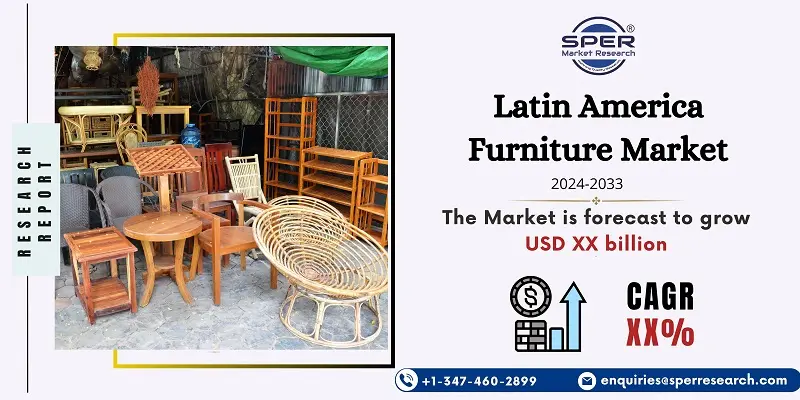
Latin America Furniture Market Growth, Size, Trends, Share, Revenue, Demand and Future Outlook
Latin America Furniture Market Size- By Material Types, By Application- Regional Outlook, Competitive Strategies and Segment Forecast to 2033
| Published: Mar-2024 | Report ID: FMCG2463 | Pages: 1 - 156 | Formats*: |
| Category : Consumer & Retail | |||
- Due to the epidemic, the Santos Andira Furniture brand made its first online purchase in 2021, opening up a crucial new market for the largest retailers in Brazil out of hundreds of enterprises. Retailers are modifying their approaches and exploring mergers and acquisitions (M&A) to facilitate the shift of novice consumers to online buying. With the assistance of Via Varejo salespeople, Santos completed five more online purchases in four months, earning commissions for the store's agents.


| Report Metric | Details |
| Market size available for years | 2020-2033 |
| Base year considered | 2023 |
| Forecast period | 2024-2033 |
| Segments covered | By Material Types, By Application |
| Regions covered | Brazil, Peru, Columbia, Rest of Latin America |
| Companies Covered | Arteqiri, Ashley Furniture, Dalla Costa, Fontenla, IKEA, LineaBrasil, Politorno, Santos Andira, Techni Mobili, Others. |
- Homeowners
- Renters
- Newlyweds
- Young Professionals
- Parents
- Interior Designers
- Commercial Sector
| By Material Types: |
|
| By Application: |
|
| By Region: |
|
- Latin America Furniture Market Size (FY’2024-FY’2033)
- Overview of Latin America Furniture Market
- Segmentation of Latin America Furniture Market By Material Types (Plastic, Wood, Metal, Others)
- Segmentation of Latin America Furniture Market By Application (Residential, Commercial)
- Expansion Analysis of Latin America Furniture Market
- Problems and Obstacles in Latin America Furniture Market
- Competitive Landscape in the Latin America Furniture Market
- Impact of COVID-19 and Demonetization on Latin America Furniture Market
- Details on Current Investment in Latin America Furniture Market
- Competitive Analysis of Latin America Furniture Market
- Prominent Players in the Latin America Furniture Market
- SWOT Analysis of Latin America Furniture Market
- Latin America Furniture Market Future Outlook and Projections (FY’2024-FY’2033)
- Recommendations from Analyst
1.1. Scope of the report1.2. Market segment analysis
2.1. Research data source2.1.1. Secondary Data2.1.2. Primary Data2.1.3. SPER’s internal database2.1.4. Premium insight from KOL’s2.2. Market size estimation2.2.1. Top-down and Bottom-up approach2.3. Data triangulation
4.1. Driver, Restraint, Opportunity and Challenges analysis4.1.1. Drivers4.1.2. Restraints4.1.3. Opportunities4.1.4. Challenges4.2. COVID-19 Impacts of the Latin America Furniture Market
5.1. SWOT Analysis5.1.1. Strengths5.1.2. Weaknesses5.1.3. Opportunities5.1.4. Threats5.2. PESTEL Analysis5.2.1. Political Landscape5.2.2. Economic Landscape5.2.3. Social Landscape5.2.4. Technological Landscape5.2.5. Environmental Landscape5.2.6. Legal Landscape5.3. PORTER’s Five Forces5.3.1. Bargaining power of suppliers5.3.2. Bargaining power of buyers5.3.3. Threat of Substitute5.3.4. Threat of new entrant5.3.5. Competitive rivalry5.4. Heat Map Analysis
6.1. Latin America Furniture Market Manufacturing Base Distribution, Sales Area, Product Type6.2. Mergers & Acquisitions, Partnerships, Product Launch, and Collaboration in Latin America Furniture Market
7.1. Latin America Furniture Market Value Share and Forecast, By Type, 2024-20337.2. Plastic7.3. Wood7.4. Metal7.5. Others
8.1. Latin America Furniture Market Value Share and Forecast, By Application, 2024-20338.2. Residential8.3. Commercial
9.1. Latin America Furniture Market Size and Market Share
10.1. Latin America Furniture Market Size and Market Share By Material Types (2020-2026)10.2. Latin America Furniture Market Size and Market Share By Material Types (2027-2033)
11.1. Latin America Furniture Market Size and Market Share By Application (2020-2026)11.2. Latin America Furniture Market Size and Market Share By Application (2027-2033)
12.1. Latin America Furniture Market Size and Market Share By Region (2020-2026)12.2. Latin America Furniture Market Size and Market Share By Region (2027-2033)12.3. Brazil12.4. Peru12.5. Columbia12.6. Rest of Latin America
13.1. Arteqiri13.1.1. Company details13.1.2. Financial outlook13.1.3. Product summary13.1.4. Recent developments13.2. Ashley Furniture13.2.1. Company details13.2.2. Financial outlook13.2.3. Product summary13.2.4. Recent developments13.3. Dalla Costa13.3.1. Company details13.3.2. Financial outlook13.3.3. Product summary13.3.4. Recent developments13.4. Fontenla13.4.1. Company details13.4.2. Financial outlook13.4.3. Product summary13.4.4. Recent developments13.5. IKEA13.5.1. Company details13.5.2. Financial outlook13.5.3. Product summary13.5.4. Recent developments13.6. LineaBrasil13.6.1. Company details13.6.2. Financial outlook13.6.3. Product summary13.6.4. Recent developments13.7. Politorno13.7.1. Company details13.7.2. Financial outlook13.7.3. Product summary13.7.4. Recent developments13.8. Santos Andira13.8.1. Company details13.8.2. Financial outlook13.8.3. Product summary13.8.4. Recent developments13.9. Techni Mobili13.9.1. Company details13.9.2. Financial outlook13.9.3. Product summary13.9.4. Recent developments13.10. Others
SPER Market Research’s methodology uses great emphasis on primary research to ensure that the market intelligence insights are up to date, reliable and accurate. Primary interviews are done with players involved in each phase of a supply chain to analyze the market forecasting. The secondary research method is used to help you fully understand how the future markets and the spending patterns look likes.
The report is based on in-depth qualitative and quantitative analysis of the Product Market. The quantitative analysis involves the application of various projection and sampling techniques. The qualitative analysis involves primary interviews, surveys, and vendor briefings. The data gathered as a result of these processes are validated through experts opinion. Our research methodology entails an ideal mixture of primary and secondary initiatives.



Frequently Asked Questions About This Report
PLACE AN ORDER
Year End Discount
Sample Report
Pre-Purchase Inquiry
NEED CUSTOMIZATION?
Request CustomizationCALL OR EMAIL US
100% Secure Payment






Related Reports
Our Global Clients
Our data-driven insights have influenced the strategy of 200+ reputed companies across the globe.




















